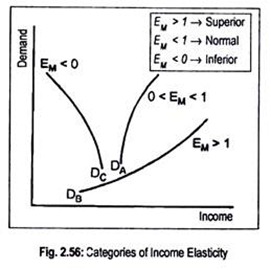Let us study about the Income Elasticity of Demand. After reading this article you will learn about: 1. Concept of Elasticity of Demand 2. Different Values of Income Elasticity of Demand.
Concept of Elasticity of Demand:
The concept of elasticity of demand can be broadened to measure the response of quantity demanded to any of the factors affecting the demand for a commodity. Besides the price of the commodity under consideration, we should know how changes in income and in the price of other commodities affect elasticity of demand.
As incomes rise consumers normally increase their demands for most of the commodities they consume. The responsiveness of demand to changes in income is measured by using the concept of income elasticity of demand.
It is denoted by EM and is expressed as:
ADVERTISEMENTS:
EM= % change in quantity demanded/% change in income
EM = ∆Q/Q ÷ ∆M/M = ∆Q/∆M. Q/M
Different Values of Income Elasticity of Demand:
Income elasticity varies from plus infinity to minus infinity. For most commodities we observe that increase in income leads to an increase in quantity demanded. Such goods are called normal goods. On the other hand, there is a class of goods the demand for which falls as income rises.
Such goods are called inferior goods. Normal goods have positive income elasticity; inferior goods have negative income elasticity. The boundary between the two is zero income elasticity, corresponding to the case where a change in income leaves quantity demanded unchanged.
ADVERTISEMENTS:
Fig. 2.56 shows the relationship between income and quantity demanded for the three types of goods. Good A is a normal good (or non-inferior good) with positive income elasticity of demand (0 < EM< 1) (DA curve). A normal good or a non-inferior good is one whose coefficient of income elasticity is positive but less than one.
One may also call such normal good as a necessary good. EM is positive because income and demand move in the same direction. Its coefficient is less than one because a change in income causes a smaller change in quantity demanded. If EM > 1, then the good is said to be a luxury one (DB curve). Further, there are some goods whose demand falls as income rises.
In other words, if income and demand move in opposite directions then EM < 0 and such commodity is called inferior commodity (Dc curve). These three types of commodity showing negative, positive but less than one, and positive elasticity have been shown in Fig. 2.56.
ADVERTISEMENTS:
The boundary between positive and negative elasticities is zero income elasticity (EM = 0). If quantity demanded remains invariant consequent upon a change in money income, then EM becomes equal to zero.
